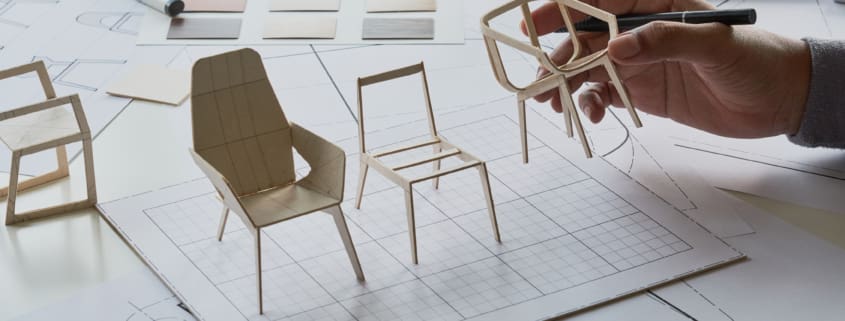Furniture Design with Charles Curbbun at Domas Academy
Our CEO and Chief, Charles Curbbun, recently taught a ten-week course on furniture design at the Domas Academy School of Design. It was an instructional course in furniture design and development, with a focus on the physical and emotional interaction between a specific furniture piece and its surrounding space. Charles also dove deep into the interpersonal relationships between client and designer that facilitate the accuracy and quality desired by each party.
Furniture Design at Domas Academy
Charles encouraged his students to be bold and creative in order to establish “a faucet of unrestricted ideas, then a funnel of interpreted concepts.” The focus was on capturing creativity within a defined process, and applying design thinking and creativity to assessing the desired emotional response the piece was to evoke from within the space. Each student took turns playing the role of “Client and Designer,” with the goal being to work together in order to guide the designer to a new and relevant idea/experience/seat that WOWs the client.
Each student acting as a Client shared about their lives and personal creative preferences such as their favorite architect, designer, and other life inspirations. Students acting as a Designer then developed a storyline derived from the Client’s input as a basis for their Design’s aesthetic direction and style. They achieved a working concept quickly, but found that it was only with sustained personal development that they could define the final product/experience. The process was driven by a dedication to constant client interaction and finding solutions from asking the right questions and understanding how to translate the client’s thoughts to a three-dimensional piece. The process had its struggles, but nothing dedication couldn’t overcome.
“The tough part was making full size mockups, but this was also the way we grew as designers,” said Charles.
Charles wanted his students to free their minds, as he preaches to his team at DDSTUDIO, in order to open the door to a full spectrum of thought processes, from hands-on analytics to emotional intuition. The Designer was to build confidence through trial and error, and the willingness to fully grasp the Client’s tentative idea. Steady improvement came from multiple sketch attempts, in which the Designer would then present and explain his or her take on why the design fits the Client’s briefs. Through this channel of discussion, the Designers learned how to effectively communicate and utilize feedback for momentum moving forward.
The goal was to always demonstrate that a great designer balances the potential product’s form, function, and style with the essence of the Client’s suggestions. The design must capture and transcend the Client’s experience, using their ideas to develop a product they always wanted but didn’t exactly know how to describe; to bring to life what they felt but couldn’t see themselves.
Any specific design inherently elicits a certain behavioral reaction, whether it’s an emotional pull of a unique design or the physical feeling one gets when sitting on the furniture. The students came to understand that all designs have a certain power within their space. This is why the client’s recommendations of their favorite designers were key to setting the defined limits for the students to work in. Creativity comes from limits, especially for the physical manifestations of furniture, as a designer must engage with every aspect of a set space to understand how a certain piece when added to this space may affect behavioral change.
Ultimately, Charles was personally impressed by the students’ content and quality of work, along with their dedication to actualize their ideas into tangible mockups. The students that excelled had similar aesthetic interests that generated a naturally productive designer/client relationship. Designer Matthew Padilla teamed up with client Quynn Dang to create a project titled “Embrace.” The plot was a “seat for a sophisticated lover of life” that would demonstrate “a kinetic approach to sculptural seating.” Padilla found inspiration in the passion derived from Dang’s Vietnamese roots. “Unpretentious, humble, and pure in manner, her perspective of the deep qualities of existing, form an absolutely holistic witness who pursues only the most elusive of the natural,” said Padilla.
Another impressive piece came from designer Carlos Gonzales and his project titled “El Presidente.” The inspiration for the plot was “a lounge for the master of political media” demonstrating a “flowing update on LaChaise.” Gonzales worked with Marcelo Kertesz as his client, whose fellow sense of humor really drove the process. “My client is Marcelo- a man with goals…Always willing to learn and achieve, his main goal is to DO NOTHING,” said Padilla. With this, Padilla set out to create the perfect chair to embrace the art of doing nothing, working with the dark and elegant Brazilian Ironwood, which was crafted to perfection in a CNC machine. The dedication to every aspect of the design process resulted in these unique and intriguing pieces, showcasing the power of combining personality and aesthetic, and finding creative authenticity derived from people’s lives.
Charles is the founder of DDSTUDIO, Southern California’s premier experience design strategy and development firm. DDSTUDIO designs and builds beautiful and useful products for their clients that help revolutionize the look and feel of tomorrow. Charles holds numerous patents and awards related to his designs.
Some of the modern furniture designers who inspire us with their humanistic design approach that make technology and environments more meaningful are:
Charles and Ray Eames http://www.eamesoffice.com/
Michael Graves http://michaelgraves.com/
Masamichi Udagawa and Sigi Moeslinger http://www.antennadesign.com/





